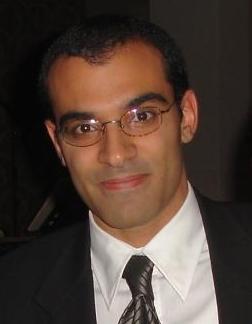
Name: Patrick S. Tawadros, MD, PhD, FRCS(C)
Title: Clinical Fellow
Institution: University of Minnesota
Clinical Specialty: Colon and Rectal Surgery
Research Interest: Cell signaling in inflammation
Institution during SIS Fellowship: University of Toronto
SIS Fellowship Mentor: Ori Rotstein, MD
SIS Fellowshp Project Title: The Role of Ceramide Production in Oxidant-induced LPS signaling
Fellowship Years: 2005-2006
Fellowship Publication:
- Tawadros PS, Powers KA, Yang I, Becker DA, Ginsberg MD, Szaszi K, Kapus A, Rotstein OD. Stilbazulenyl nitrone decreases oxidative stress and reduces lung injury after hemorrhagic shock/resuscitation and LPS. Antioxid Redox Signal. 2007 Nov;9(11):1971-7.
- Powers KA, Szászi K, Khadaroo RG, Tawadros PS, Marshall JC, Kapus A, Rotstein OD. Oxidative stress generated by hemorrhagic shock recruits Toll-like receptor 4 to the plasma membrane in macrophages. J Exp Med. 2006 Aug 7;203(8):1951-61.
How did you hear about the SIS Fellowship? From my supervisor, Dr. Ori D Rotstein. He explained that the SIS is an organization that includes surgeon-scientists with similar research interests and we should therefore plan to present our work at their meetings and apply for their highly competitive fellowship support.
Who was the main influence on your choice to become an academic surgeon? My PhD supervisor, Dr. Ori D Rotstein, and previously, my first summer research position supervisor, Dr. Charles H Tator. By working with these highly respected and inspiring academic surgeons through my research summer positions during medical school and in my graduate studies during residency, I developed a deep respect for academic surgery and an eagerness to pursue such a career.
How did you get involved in surgical infections research? I had the good fortune of meeting Dr. Rotstein early in my career as a medical student. I quickly became interested in joining his exciting research field in the context of our Surgeon Scientist Program.
Can you describe how the fellowship helped your career? The fellowship was instrumental in helping launch my career as a surgeon scientist. It was my first substantial award and will always hold that special place in my career path. The SIS fellowship came at the beginning of my research period in Dr. Rotstein’s lab. Over the next 4 years, I completed a PhD, and it is my hope to continue this line of research once my surgical training is complete.
How did you get involved in surgical infections research? Performing CLP in rats as a fourth year student at the University of Michigan. I was working with a pediatric surgeon because I was interested in pediatric surgery.
Can you describe how the fellowship helped your career? It allowed me to be involved in the SIS. Eventually, it helped me understand the relationship between science and clinical practice.
Did you obtain further research funding in this area? Yes, I later received the American College of Surgeons’ research scholarship.
What would you tell medical students who are interested in surgery? That surgery is the greatest job in the world, but it’s not for everybody. If at all interested, you have to create an opportunity for yourself to experience the world of surgery, whether it be through a mentorship program, a summer research position, or an elective.
What suggestions would you give to residents who would like to pursue research projects? I would strongly advise residents to seek out funding opportunities from Societies in their area of research. It’s an excellent way to gain funding while being introduced to the people whose papers you will read!
How did you first get involved in the Surgical Infection Society? During my time in Dr. Rotstein’s lab, I gave basic science presentations at five SIS meetings in a row.
What was it like to attend the SIS Meeting as a resident? Very exciting, mostly for the opportunity to meet the players in the field and get their feedback and questions on the research we were conducting. The travel and friendships formed are obviously also much appreciated aspects of attending society meetings. My first talk was a podium presentation at the 2005 SIS meeting in South Beach Miami - probably one of my most memorable meetings.
How so? Why should young investigators get involved in SIS? It’s a great society where significant scientific inquiry is fostered, both at the basic science and clinical levels, in an atmosphere of collegiality. The SIS has been extremely welcoming and supportive of me as a resident. I look forward to continued involvement during my career.